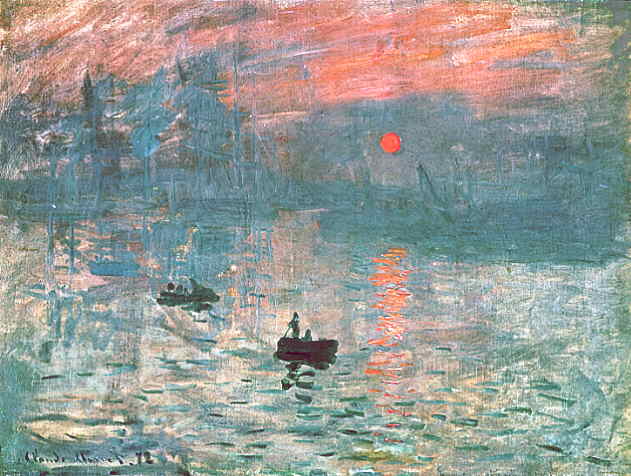- Artemisia Gentileschi Self-Portrait as the Allegory of Painting 1630; Hannah Wilke S.O.S. Starification Object Series 1974 -1982
- GoyaThe Third of May,1808 The Execution of the Defenders of Madrid 1814; Pablo Picasso Guerinca 1937.




So why are there so few paintings like these? Well we can thank the camera for that. With the birth of the camera there was no need for super realistic paintings – those who weren't artists didn't see the beauty within it, it was just a waste of time to them since they could just capture any moment with the camera.
Painters needed something different in order for their paintings to sell, something that hasn’t been done yet. So since a camera is able to capture a moment in time down to the last detail, its only logical that the painter reversed that and took an image and reduced its accuracy to realism and made something new.
But how and why did impressionism stick? It was because impressionist artists combined two things together - realism and its opposite, in order to create a new type of art. If an impressionist painting is looked up close, the first thing you would notice is the direction of the strokes, the lines, the texture. But from far away it looks as though the image could be a realistic painting. Impressionistic paintings had their own charm that was greatly accepted into their time period at the time - though very short lived.

(Jean-Louis Ernest Meissonier - Dragon a Cheval 1870-91)
So why and how is this a win and a loss? A win is that we gave birth to a new art movement, one that was incredibly different yet still exposed raw talent. The natural artist fended for himself in order to find a way to have a sufficient income as well as stick to what they do best. But here's where the loss comes in: we lose the promotion and continuation of the realistic paintings such as the ones done by Marie Rosalie Bonheur, which were in most cases the outright determination of true talent.
-Athena Loizos


The Impressionist movement of 19th century France sought to capture “an instantaneous impression of a scene in nature.” Impressionists and Post-Impressionists like Claude Monet and Paul Cezanne provided inspiration to a wide range of people involved in the creative arts. The influence of Cezanne in particular, spans from Picasso and Matisse, naming him “the father of us all,” to the unlikely industry of modern video games.
Video game company Nintendo admitted that the art for its newest game “The Legend of Zelda: Skyward Sword” was inspired by Impressionism, as well as Post-Impressionist Paul Cezanne. This art direction can be seen as an aesthetic choice, as well technologically necessary. Nintendo’s Wii system is known for lacking the technological prowess of other consoles and personal computers; it has trouble rendering the “realistic” models of the latest graphic-intensive video games. Nintendo is well aware of this technological hurdle, thus they opt for a greater emphasis on art direction rather than high definition textures. This choice creates a parallel to the impressionist movement if we think of “high end” graphics as Realism, and Nintendo’s “art direction” as Impressionism.
Skyward Sword displays distant landscapes in a very impressionistic way; they seem painted with small brush strokes and the forms meld to create a single landscape. The characters and environments closest to the player appear comparatively solid however. Though the game isn’t exactly a moving Impressionist painting, the influence is clear.
The game utilizes a bright pallet, (not fully expressed by my personal screen shots) much like the Impressionists .The Impressionist goal of capturing “the transitory effects of light and atmosphere” is fundamentally captured in the game, because what better way to express moving light than to actually have it move? Cezanne’s concerns are also addressed: the character models are solid and durable, and they exist within the landscape, but do not melt into it. Arguably, the aesthetic of Skyward Sword is timeless compared to the graphics of other contemporary games striving for realism, since it is inevitable that they will be surpassed by future games as technology develops.
When comparing a screen shot of the game and Cezanne’s Mont Saint-Victoire from c.1885, we can see the influence in the mountain and the depiction of the sky, a similar palette is also utilized by both.
Other comparisons that show influence from Cezanne:
Promotional concept art compared to Cezanne’s Mont Sainte-Victoire seen from Bellevue.
Compared to Road Before the Mountains, Sainte-Victoire
1898–1902
Monet also lends inspiration:
Promotional art compared to Monet's The Cliffs at Etretat.
-Nick Pantelaros
Sources: The class textbook, http://www.zeldauniverse.net/zelda-news/skyward-swords-visuals-impressionistic/ , and personal play time and pictures.
I also found a video dealing with this same idea, and it shows the game in motion.